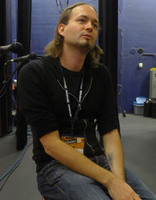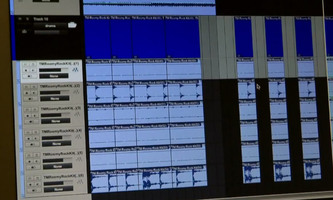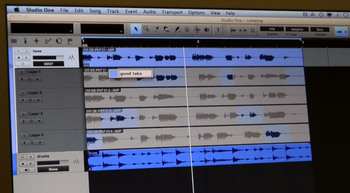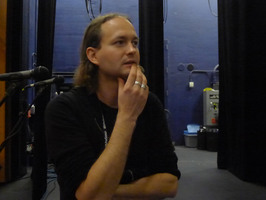Coinciding with the launch of Studio One v2.5, AudioFanzine met up with Matthias Juwan, technical director at PreSonus in Hamburg, Germany, to talk about his career, the future of the Studio One sequencer, and the software department at PreSonus. Interview...
Hello Matthias, what is your job at PreSonus?
I’m the CTO (Chief Technology Officer) at the office based in Hamburg, Germany, that deals with all software activities of PreSonus. There is another CTO in Baton Rouge (Louisiana, USA) in charge of hardware. Here, we work mainly on Capture and Studio One, but we have also started to work on the upcoming software for the Studio Live mixers. My goal is to expand the office in Hamburg so that we become an important piece within the PreSonus team.
Please tells us more about your professional career.
I started working with music software 12 years ago. I studied computer science and as part of my final project I presented the first version of Kristal Audio Engine,
which had only four tracks. I also used this to apply for a job at Steinberg. Back then, Cubase was in version 3.5 or 3.7 and I knew the software because I was playing in a band. They hired me in 2000 and I worked for them until 2006. In the beginning, I worked in the “consumer” department (Clean, My Mp3), then on Cubase SX (I designed the step sequencer) and also within the HALion team for two or three years. At the same time I worked on the Plex virtual synth… At first, I was very happy to work at Steinberg, but Pinnacle bought us out, and after that Yamaha. I didn’t really have any prospects in the company anymore… That’s why I started to develop Kristal Audio again during my spare time. I made version 4 (16 tracks) available for free and I got lots of positive feedback, which gave me the motivation to go on. I started again from scratch with a new code and framework called K2 Project at the time. Of course, I still kept my day job at Steinberg during this period… But I really felt like having my own personal project. I was in touch with possible investors, especially Behringer, which added Kristal Audio to some of their bundles. But nobody really felt like investing money in the project. Wolfgang (Kundrus), whom I knew from Steinberg, came to me because he knew people at PreSonus. Together, we founded the Kristal Labs company in the summer of 2006 in Hamburg. Our first project was Capture for PreSonus. And we used my K2 source code to build the foundations of Capture. In the meantime, we also started to work on the sequencer that would become Studio One…
Was it easy for you to make Studio One not only a bundled software but a full-fledged DAW?
In fact, it turned out to be pretty easy because PreSonus was interested in the idea of having their own DAW. In the USA, Pro Tools had an important market share and it needed a competitor.
Was it easy to work with PreSonus?
Wolfgang and I created a great team in Hamburg, with other former Steinberg employees. PreSonus finances everything and gives us valuable advice, but we have remained free in terms of creativity. They have confidence in our team. In 2009, we decided to merge with PreSonus, so Kristal Labs ceased to exist and we became Presonus Software.
How does this affect your daily work?
It was a long process; we had to choose between working on different projects for different companies or working for a single company and reduce the number of projects. Right now, we’re working on Capture and Studio One only, but we have future projects. For us, the best decision for the product was to merge with PreSonus. And personally, I feel very comfortable in this big company.
Are you a musician?
Musician would be going a bit too far, I’m a rather unskilled bass player. I used to play in different bands but since I started to code, I have less time for music…
How does this help you to program a DAW software?
You must understand what the user expects, but first of all you must define your goals. Who are the typical users? With Studio One we are mainly targeting musicians who record themselves. The team in Baton Rouge provides the point of view of a “standard musician, ” while we are more keen on electronic music in Hamburg. Our job is to define features and a workflow that makes sense for the musician. We certainly can’t satisfy everybody, but we are trying to make a consistent software tool.
Who decides the features in Studio One?
The team, and that’s our strength. We collect ideas from people in our team in Hamburg, PreSonus people at Baton Rouge, power users, beta testers, web forums… The feature list is long and we have to choose the best ideas first and, even more important, we have to wait for the right time to implement them. Sometimes, you must wait until you have the foundations and avoid skipping out on some steps in the development process.
Do you have a road map for two or three years?
Yes, we call it “blue sky.” It includes what we would like to do ideally if we had unlimited resources. Of course, we have to make compromises because we are a small team.
In your mind, what is Studio One’s best feature?
To me, the main advantage of Studio One is the workflow, the way the different sections of the program are embedded in the software. For example, drag 'n’ drop is possible almost anywhere in the program. Some users don’t even know how many things they can drag and drop! That’s the main advantage of having recoded everything from scratch. We worked on the basics and had to mix standard features with new ones.
Is it an advantage to work on a young software compared with much more older competitors?
There are pros and cons. We have no legacy to live up to nor users that don’t like to be upset. To be able to start with a certain freshness is certainly an opportunity. But, on the other hand, we had to spend a lot of energy to develop the foundations of the software before having the possibility to introduce real new features. Users will find in Studio One some of the features known from similar products like Cubase, Logic, Pro Tools, but also features only available in Studio One.
Did you spend a lot of time analyzing competitor software?
Yes. For example, we have been clearly influenced when it comes to shortcuts. Keep in mind that 2/3 of the team comes from Steinberg. But we do (and are still doing) a lot of research. Finally, you must always come back to the user… Some of them ask for features and options from Cubase or Logic. In such cases we ask what the actual problem is, so that we can reconsider a way to solve it and stay faithful to our philosophy.
When you see a Studio One feature in a competitor product, do you feel pride or anger?
For me, this means that the competition fears us. It’s exactly what happened with Cakewalk when they launched Sonar X1: it was a bit annoying because they used the same colors, the same gray, the same blue… But this only means that we are attracting their attention and we are becoming more important, which is in the end a good thing. When Logic 8 or 9 was introduced, the window layout changed. It was one or two years before the first Studio One version, and we got scared because this Logic version looked pretty close to what we planned to do… As if they had peeped through our window…! But in the end, certain things are just logical and evident.
We asked for the strengths of Studio One, now tell us about its weaknesses? And how can you improve them?
There are still some weak points. Certain features still lag behind competitors because they have developed their products longer than we have. Even if we are few and young, it’s always a challenge to keep a certain coherence. There are still some inconsistencies in Studio One, some features aren’t perfect yet. For instance, the global and song setups: it’s still possible to make conflicting settings, deliberately or not. In such a case, the application doesn’t crash, so there is no drama, but it’s important to keep the number of options and settings low, and even more to keep a consistency between all these parameters. One of our main strengths is that we are not afraid of cutting some features. For example, the comping feature in version 2.0: we knew we would not have enough time to finish it properly, so we decided to wait until it was fully mature before introducing it. The same applies to a shortcut, which we removed to improve the workflow.
Version 2.5 just came out. Are you already working on v 3.0?
Yes, we are thinking about it!
What are you working on?
Unfortunately, I cannot comment on that! But I can tell you that there are still ongoing discussions about it. In the future you’ll see new collaborations, like the current one we have with Celemony (inventor of Melodyne).
Unlike some other manufacturers, like Steinberg, we don’t try to do everything ourselves. We are not isolated from the rest of the world and we stay open to other companies. By the way, there are a lot of opportunities!
What do you think about a project like Ohm Studio, which is using the Cloud in an intelligent way?
I met one of their developers at the Musikmesse this year and we had a very interesting discussion. They are very ambitious. They have a lot of work coming and I have a lot of respect for them! But, coming back to Studio One: right from the start, we’ve always thought about thinks like sharing data with Exchange and SoundCloud integration… And we will continue in this direction because collaborations are always very interesting. Exchange is only a small step, it’s only the beginning.
How do you think the DAW market will look like in 10 years? What will be the next major evolution?
Several things will happen. Regarding the GUI, touch features will surely start to appear, which is something that interests us a lot at PreSonus. The second thing is collaborations, like I mentioned before. It’s not improbable that we associate with someone else to reach the next level. The third idea applies to hardware. Basically, PreSonus is a hardware manufacturer and one of our challenges is the perfect integration of software and hardware. We are also looking at solutions to transfer StudioLive sessions to Studio One, etc. We have so many things to do!




